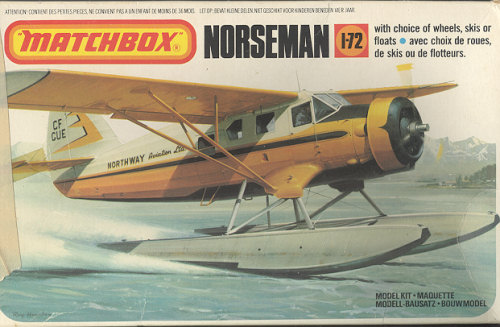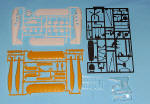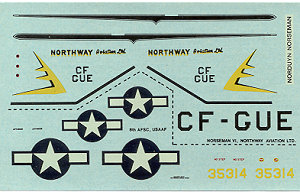
| KIT: | Matchbox 1/72 UC-64A Norseman |
| KIT #: | PK 125 |
| PRICE: | $ Long out of production |
| DECALS: | Two options |
| REVIEWER: | Scott Van Aken |
| NOTES: | Molded in three colors! |

| HISTORY |
The Noorduyn Norseman is a Canadian single-engine bush plane designed to operate from unimproved surfaces. Norseman aircraft are known to have been registered and/or operated in 68 countries throughout the world and also have been based and flown on the Arctic and Antarctic continents. The Norseman was the plane that Glenn Miller was flying in when it disappeared somewhere over the English Channel.
Designed by Robert B.C. Noorduyn, the Noorduyn Norseman was produced from 1935 to 1959, originally by Noorduyn Aircraft Ltd. and later by the Canada Car and Foundry company.
With the backbround of working on many ground-breaking designs at Fokker, Bellanca and Pitcairn-Cierva, Noorduyn decided to create his own design in 1934, the Noorduyn Norseman. Along with colleague, Walter Clayton, Noorduyn created his original company, Noorduyn Aircraft Limited in early 1933 at Montreal while a successor company bearing the name, Noorduyn Aviation, was later established in 1935.
Noorduyn's vision of a bush plane revolved around a few basic criteria: it should be an aircraft with which a Canadian operator utilizing existing talents, equipment and facilities could make money, it should be a high wing monoplane to facilitate loading and unloading of passengers and cargo at seaplane docks and airports and, finally, it should be an all-around superior aircraft to those in use in Canada. The final design layout looked much like Noorduyn's earlier Fokker designs with all-welded steel tubing fuselage structure and wood stringers were applied to it for attachment of a fabric skin. The wing was all wood construction and fabric covered except for the flaps and ailerons, which were made of welded steel tubing.
The first Norseman was flight tested on floats 14 November 1935 and was sold and delivered to Dominion Skyways Ltd. on 18 January 1936. Almost immediately, the Norseman proved itself to be a rugged reliable workhorse but the production run may have ended at a few hundred examples if not for the advent of the Second World War. A total of 903 Norseman aircraft (Mk. I - Mk. V) were produced and delivered to various commercial customers. The Royal Canadian Air Force and the United States Air Force became the two largest operators, with the American military placing orders for 749 Norseman aircraft. The USAAF Norseman aircraft were used in North America (primarily Alaska) as well as other theatres of war, including the European.
In postwar production, the Canada Car and Foundary in Fort William, Ontario acquired rights to the Norseman design, producing a version known as the MK. V, a civilian version of the wartime Mk. IV. In order to exploit the market further, the "Can Car" factory designed and built the Mark VII. This version had a bigger engine, a new all-metal wing and greater cargo capacity but was fated never to go into production. With large Korean War commitments at that time, the company put it into temporary storage where it was destroyed in a hangar fire in September 1951.
In 1953, Noorduyn headed a group of investors who bought back the jigs and equipment from Canada Car and Foundary and started a new company called Noorduyn Norseman Aircraft Ltd. Bob Noorduyn became ill and died in in his home in South Burlington, Vermont on 22 February 1959 but the company he had created, provided support for operating Norseman aircraft and even built three new Mk Vs before selling its assets in 1982 to Norco Associates. Norco provided service only, as the manufacture of a new Norseman aircraft, being very labor intensive, made it very expensive.
The last Norseman built was sold and delivered to a commercial customer on 19 January 1959. Approximately 18 Norseman aircraft are still in use as of 2005. There are also examples in several museums around the world, a nice one is nearby at the USAF Museum in Dayton, Ohio.
| THE KIT |
 Molded
in three colors, as befitting a type '100' kit, the Matchbox Norseman is
actually quite a nicely done kit. First thing one notices, aside from the white,
yellow and dark blue plastic, is that there are options for skis, wheels and
floats, something you rarely find in kits nowadays. Were this being done in
today's market, you'd have this boxed as three different kits.
Molded
in three colors, as befitting a type '100' kit, the Matchbox Norseman is
actually quite a nicely done kit. First thing one notices, aside from the white,
yellow and dark blue plastic, is that there are options for skis, wheels and
floats, something you rarely find in kits nowadays. Were this being done in
today's market, you'd have this boxed as three different kits.
One also will note the paucity of interior detail, there being but two seats and an instrument panel for the two yellow pilots. There is some detail on the panel, but it is a bit soft. The seats are also quite generic as I'm sure the Norseman had lightweight frame and canvas seats. There is no cabin detail, just a floor. The fabric covered wings and horizontal stabs are a perfect example of the 'hill and valley' effect used by many companies to show this type of constructions. There is a fairly nice engine to fit into the one piece cowling.
Basically, you can build one of two version, the civil type having more options. This version uses a three bladed prop and depending on how you wish to go, you can either install floats, skis or wheels. Bush planes often had to land on different surfaces depending on the job requirements. There are different attachment parts for the lower gear sponsons depending on the option selected. I was impressed by how un-complex the float arrangement was.
For the military version, only the wheeled option is
shown. I'm sure most of these planes operated on wheels with those up in Alaska
using any of the available gear. It is really a shame that one of those nice
silver with red bits aircraft was
not chosen as a marking possibility. To show the age of the kit, a stand is
included.
red bits aircraft was
not chosen as a marking possibility. To show the age of the kit, a stand is
included.
The instructions are typical of old Matchbox kits with several nicely drawn construction sequences. All the painting is shown at the end of the instructions with generic colors given. The back of the box shows a full color three view markings plan for both options. The box art plane is the bush aircraft from Northway Aviation Ltd in white and yellow with silver floats (hence the color choices for the plastic, no doubt). The military version is a very generic OD/Neutral Grey version with invasion stripes (which will have to be painted on). The decals look nicely done, though from past experience, I can tell you that they are a bit transparent.
| CONCLUSIONS |
This really is a nice kit. Not real detailed, but the basics are there if one wants to add stuff. It is one of those kits that no one else but Matchbox would produce and as such, is worthy of those who like their modeling a bit off the main track.
| REFERENCES |
Wikipedia
Thanks to me for finding this one at a swap meet last year.
December 2006
If you would like your product reviewed fairly and quickly by a site that has over 325,000 visitors a month, please contact me or see other details in the Note to Contributors.